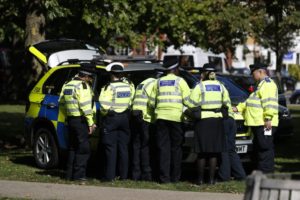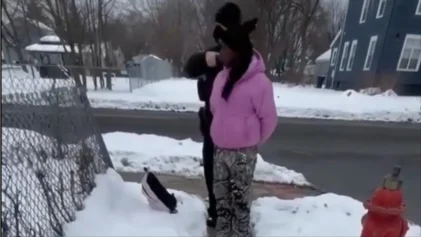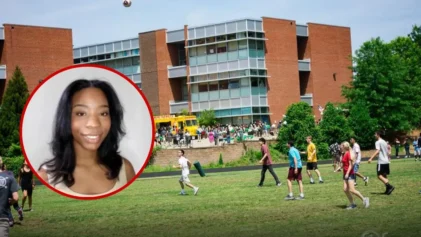
Police and community support officers gather near where an incident occurred that police are investigating as a terrorist attack at Parsons Green subway station in London. (AP Photo/Kirsty Wigglesworth)
LONDON (AP) — Hundreds of London police embarked on a massive manhunt Friday, racing to find out who placed a homemade bomb on a packed London subway train during the morning rush hour. The explosion wounded 22 people and ignited a panicked stampede to safety.
Witnesses described seeing a “wall of fire” as the bomb — hidden in a plastic bucket inside a supermarket freezer bag — went off about 8:20 a.m. while the train was at the Parsons Green station in southwest London.
It was not a large explosion, and British police and health officials said none of the injured was thought to be seriously hurt. Yet, police said it was a terrorist attack, the fifth in Britain this year.
Six hours later, the Metropolitan Police force said there had been no arrests, but hundreds of detectives, aided by intelligence agents, were looking at surveillance camera footage in the subway, carrying out forensic work and speaking to witnesses.
The site of the blast is in a leafy, affluent part of the city, not near any of London’s top tourist sites. British media reported that the bomb included a timer. It’s not clear whether the device was intended to explode when it did.
Police were alerted when commuters reported a noise and a flash aboard the District Line train. Commuter Lauren Hubbard was on the train when she heard a loud bang.
“I looked around and this wall of fire was just coming towards us. You just run,” said Hubbard, who fled the above-ground station with her boyfriend.
Others described “absolute chaos” as hundreds of people rushed to get away from the danger.
“I ended up squashed on the staircase. People were falling over, people fainting, crying, there were little kids clinging onto the back of me,” said Ryan Barnett, 25.
Mark Rowley, head of counterterrorism for the Metropolitan Police, said “this was a detonation of an improvised explosive device.”
He said 18 people had been injured, most with “flash burns.” Health officials later said four others hurt in the bombing went to hospital themselves.
Rowley said Britain’s domestic intelligence service, MI5, was assisting with the investigation, led by the police counter-terrorism unit.
He gave no information about potential suspects, saying “It’s very much a live investigation.”
U.S. President Donald Trump tweeted that it was another attack “by a loser terrorist,” adding that “these are sick and demented people who were in the sights of Scotland Yard.”
The London police force declined to comment on Trump’s suggestion that it knew about the attacker.
Photos taken inside the train show a white plastic bucket inside a foil-lined shopping bag. Flames and what appear to be wires emerge from the top.
“There was, out of the corner of my eye, a massive flash of flames that went up the side of the train,” witness Chris Wildish told Sky News. He said it was followed by “an acrid chemical smell.”
He said many of those on board were schoolchildren, who were knocked around as the crowd surged away from the fireball.
Commuter Richard Aylmer-Hall said he saw several people injured, apparently trampled as they fled.
“I saw crying women, there was lots of shouting and screaming, there was a bit of a crush on the stairs going down to the streets,” Aylmer-Hall, said.
During rush hour, the subway train could hold more than 800 people. Aerial footage later showed commuters from other subway trains being evacuated along the elevated track.
Transport for London said subway services were suspended along the line.
London Mayor Sadiq Khan said the city “utterly condemns the hideous individuals who attempt to use terror to harm us and destroy our way of life.”
London has been targeted by attackers several times this year, with deadly vehicle attacks near Parliament, on London Bridge and near a mosque in Finsbury Park in north London. Beyond the capital, a May 22 suicide bomb attack at Manchester Arena killed 22 people.
The London Underground has been targeted several times in the past, notably in July 2005, when suicide bombers blew themselves up on three subway trains and a bus, killing 52 people and themselves. Four more bombers tried a similar attack two weeks later, but their devices failed to fully explode.
Last year Damon Smith, a student with an interest in weapons and Islamic extremism, left a knapsack filled with explosives and ball bearings on a London subway train. It failed to explode.
In its recent Inspire magazine, al-Qaida urged supporters to target trains.
British authorities say they have foiled 19 plots since the middle of 2013, six of them since a van and knife attack on Westminster Bridge and Parliament in March, which killed five people.
Separately, French counterterrorism authorities were investigating an attempted knife attack on a soldier patrolling a large Paris subway interchange.
The Paris prosecutor’s office says counterterrorism investigators have opened a probe into Friday morning’s incident at the Chatelet station in central Paris, based on preliminary examination of the attacker’s background.
The knife-wielding assailant tried to attack a soldier with a special military force assigned to protect prominent sites following deadly Islamic extremist attacks. He was quickly arrested and no one was hurt.


